Selina Concise Mathematics Class 9 ICSE Solutions Chapter 13 - Pythagoras Theorem [Proof and Simple Applications with Converse]
Selina Concise Mathematics Class 9 ICSE Solutions Pythagoras Theorem [Proof and Simple Applications with Converse]
Selina ICSE Solutions for Class 9 Maths Chapter 13 Pythagoras Theorem [Proof and Simple Applications with Converse]
1.A ladder 13 m long rests against a vertical wall. If the foot of the ladder is 5 m from the foot of the wall, find the distance of the other end of the ladder from the ground.
Solution 1:
2.A man goes 40 m due north and then 50 m due west. Find his distance from the starting point.
Solution 2:
3.In the figure:
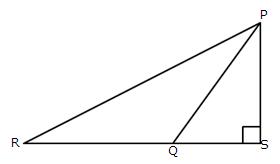
Solution 3:
4.The given figure shows a quadrilateral ABCD in which AD = 13 cm, DC = 12 cm, BC = 3 cm and
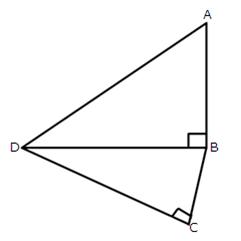
Solution 4:
5.AD is drawn perpendicular to base BC of an equilateral triangle ABC. Given BC = 10 cm, find the length of AD, correct to 1 place of decimal.
Solution 5:
6.In triangle ABC, given below, AB = 8 cm, BC = 6 cm and AC= 3 cm. Calculate the length of OC.
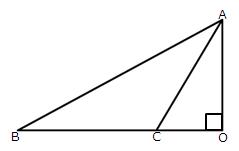
Solution 6:
7.In triangle ABC,
AB = AC = x, BC = 10 cm and the area of the triangle is 60 cm2. Find x.
Solution 7:
8.If the sides of triangle are in the ratio 1 : Selina Solutions Icse Class 9 Mathematics Chapter - Pythagoras Theorem Proof And Simple Applications With Converse: 1, show that is a right-angled triangle.
Solution 8:
9.Two poles of heights 6 m and 11 m stand vertically on a plane ground. If the distance between their feet is 12 m; find the distance between their tips.
Solution 9:
10.In the given figure, AB//CD, AB = 7 cm, BD = 25 cm and CD = 17 cm; find the length of side BC.
_files/20141015105311_image001.jpg)
Solution 10:
Take M be the point on CD such that AB = DM.
So DM = 7cm and MC = 10 cm
Join points B and M to form the line segment BM.
So BM || AD also BM = AD.
11.In the given figure, ∠B = 90°, XY || BC, AB = 12cm, AY = 8cm and AX: XB = 1: 2 = AY: YC. Find the lengths of AC and BC.
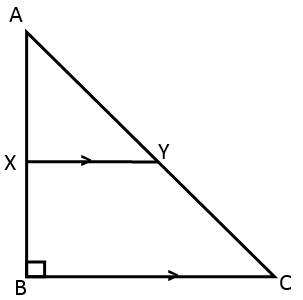
Solution 11:
Given that AX:XB = 1:2.
Let n be the common multiple for which this proportion gets satisfied.
So, AX = 1(n) and XB = 2(n)
AX = 1(n) = 4 and XB = 2(n) = 8
12.In ΔABC,
(i) AB = (x - 3) cm, BC = (x + 4) cm and AC = (x + 6) cm
(ii) AB = x cm, BC = (4x + 4) cm and AC = (4x + 5) cm
Solution 12:
Exercise 13(B)
1.In the figure, given below, AD
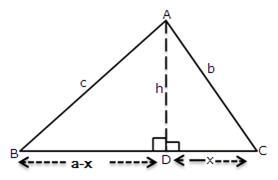
Solution 1:
2.In equilateral Δ ABC, AD
Solution 2:
3.ABC is a triangle, right-angled at B. M is a point on BC. Prove that:
AM2 + BC2 = AC2 + BM2.
Solution 3:
4.M andN are the mid-points of the sides QR and PQ respectively of a
(i) PM2 + RN2 = 5 MN2
(ii) 4 PM2 = 4 PQ2 + QR2
(iii) 4 RN2 = PQ2 + 4 QR2
(iv) 4 (PM2 + RN2) = 5 PR2
Solution 4:
5.In triangle ABC,
Solution 5:
6.In a rectangle ABCD, prove that:
AC2 + BD2 = AB2 + BC2 + CD2 + DA2.
Solution 6:
7.In a quadrilateral ABCD,
Solution 7:
8.O is any point inside a rectangle ABCD. Prove that: OB2 + OD2 = OC2 + OA2.
Solution 8:
9.In the following figure, OP, OQ and OR are drawn perpendiculars to the sides BC, CA and AB respectively of triangle ABC. Prove that:
AR2 + BP2 + CQ2 = AQ2 + CP2 + BR2
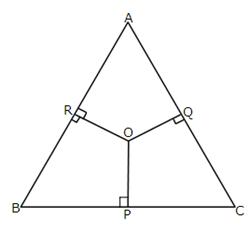
Solution 9:
10.Diagonals of rhombus ABCD intersect each other at point O. Prove that:
OA2 + OC2 = 2AD2 - _files/20141015112304_image014.gif)
11.In the figure AB = BC and AD is perpendicular to CD. Prove that:
AC2 = 2BC. DC.
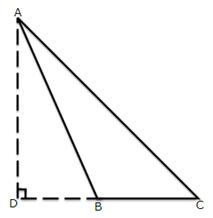
Solution 11:
12.In an isosceles triangle ABC; AB = AC and D is point on BC produced. Prove that:
AD2 = AC2 + BD.CD.
Solution 12:
13.In triangle ABC, angle A = 90o, CA = AB and D is point on AB produced. Prove that DC2 -BD2 = 2AB.AD.
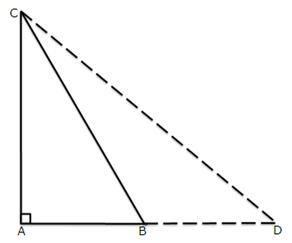
Solution 13:
14.In triangle ABC, AB = AC and BD is perpendicular to AC. Prove that: BD2 - CD2 = 2CD × AD.
Solution 14:
15.In the following figure, AD is perpendicular to BC and D divides BC in the ratio 1: 3.
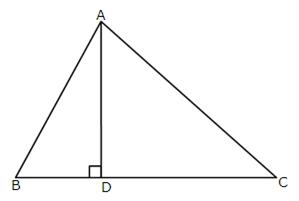
Prove that : 2AC2 = 2AB2 + BC2
Solution 15:
![Selina Concise Mathematics Class 9 ICSE Solutions Chapter 13 - Pythagoras Theorem [Proof and Simple Applications with Converse] Selina Concise Mathematics Class 9 ICSE Solutions Chapter 13 - Pythagoras Theorem [Proof and Simple Applications with Converse]](https://blogger.googleusercontent.com/img/b/R29vZ2xl/AVvXsEhxP5WvX4HvbwFnhWbOStO2U_gPccrl4gFakUV4MinXHztjrkPznU-CzwZYMyMQTm9YuI6cf2pcvM2bd_A2NvgNHUOKzgQBZjwXAuUO76aZmUwMdMAj43RvTmC7sCfdQdA93LOubjBg-Yu8/s1600/selina-concise-mathematics-class-9-icse-solutions-pythagoras-theorem-proof-and-simple-applications-with-converse.jpg)
![Selina Concise Mathematics Class 9 ICSE Solutions Chapter 13 - Pythagoras Theorem [Proof and Simple Applications with Converse] Selina Concise Mathematics Class 9 ICSE Solutions Chapter 13 - Pythagoras Theorem [Proof and Simple Applications with Converse]](https://blogger.googleusercontent.com/img/b/R29vZ2xl/AVvXsEhVorxKvt1CZo57VV2P8UlxM80k136UyT1Co_6hA3zGxkbStKpMw3MCqH6iLi7bj5BsneiHCrjdEjVWMGRiJqh654mss_MxQVZRGDUaluvz-yZSrYXW9UWoyeawEZHdNLBSokMo0jRj4kqV/s1600/selina-concise-mathematics-class-9-icse-solutions-pythagoras-theorem-proof-and-simple-applications-with-converse1.jpg)
![Selina Concise Mathematics Class 9 ICSE Solutions Chapter 13 - Pythagoras Theorem [Proof and Simple Applications with Converse] Selina Concise Mathematics Class 9 ICSE Solutions Chapter 13 - Pythagoras Theorem [Proof and Simple Applications with Converse]](https://blogger.googleusercontent.com/img/b/R29vZ2xl/AVvXsEjdAdZUMoITo7dF-DjxFkWr1L540_gMP_JxmT9WwRehwVex6xXbDi8wopKxr6VGYB3QVzKmW1Ua_6ow3FfejGECGQsBZnbTsxVbEifSZ9236mNOJW8mOYLgF62hSmEohUwGDFsj37yRAh5h/s1600/selina-concise-mathematics-class-9-icse-solutions-pythagoras-theorem-proof-and-simple-applications-with-converse2.jpg)
![Selina Concise Mathematics Class 9 ICSE Solutions Chapter 13 - Pythagoras Theorem [Proof and Simple Applications with Converse] Selina Concise Mathematics Class 9 ICSE Solutions Chapter 13 - Pythagoras Theorem [Proof and Simple Applications with Converse]](https://blogger.googleusercontent.com/img/b/R29vZ2xl/AVvXsEj21wJL1dlBvwgUuYcK0NvQ1FVcNAYpbUVFdMOFfU_cKYkxunacJnY2Kdx-lbUC0njLwpFkK8TGDtzigGMgRBkTu-WjKBeCCl92kq1Kqp32fmGcQwVStVUsMPnsJ8ocod84GSKv55SRjA1K/s1600/selina-concise-mathematics-class-9-icse-solutions-pythagoras-theorem-proof-and-simple-applications-with-converse3.jpg)
![Selina Concise Mathematics Class 9 ICSE Solutions Chapter 13 - Pythagoras Theorem [Proof and Simple Applications with Converse] Selina Concise Mathematics Class 9 ICSE Solutions Chapter 13 - Pythagoras Theorem [Proof and Simple Applications with Converse]](https://blogger.googleusercontent.com/img/b/R29vZ2xl/AVvXsEjSP1-87ZYPYtxM7DJx2QE2g-h6zNeDiTUTBzmzM77dWbBegd6kXNb9oi9m3C7TTNZzqe_w08to72ytjy8oqhJGE3fnBi7DoGSCt-eLQ1SwfqgRyHegVWp3Ykw2APBE7LqnV7NQjdiZobuS/s1600/selina-concise-mathematics-class-9-icse-solutions-pythagoras-theorem-proof-and-simple-applications-with-converse4.jpg)
![Selina Concise Mathematics Class 9 ICSE Solutions Chapter 13 - Pythagoras Theorem [Proof and Simple Applications with Converse] Selina Concise Mathematics Class 9 ICSE Solutions Chapter 13 - Pythagoras Theorem [Proof and Simple Applications with Converse]](https://blogger.googleusercontent.com/img/b/R29vZ2xl/AVvXsEhgWgTIQdI5gpb-Wei_eVEQx-FwujkA6O8B_4W8ikxYUQxf7JGhIWQPPAca4wTmCz4iiDOR3CrTPEvuNDTqy7B5PGkmdEfWF_CvlJKj2T66MJ5PCxQK_N-ewrsRPMkV68rSnP0VJAEXX3wQ/s1600/selina-concise-mathematics-class-9-icse-solutions-pythagoras-theorem-proof-and-simple-applications-with-converse5.jpg)
![Selina Concise Mathematics Class 9 ICSE Solutions Chapter 13 - Pythagoras Theorem [Proof and Simple Applications with Converse] Selina Concise Mathematics Class 9 ICSE Solutions Chapter 13 - Pythagoras Theorem [Proof and Simple Applications with Converse]](https://blogger.googleusercontent.com/img/b/R29vZ2xl/AVvXsEhOd2nBO7tpzVkJxQGi0h3OEuXyuuDR-SaWQREQZA7b_lr2TgbIMySWFjh16jqkVkYylapSIwmZ9BMclo3lF38fRP6cLaSDOz2rA7z702P9jpCpTlOjd069hlVNVqk4pD1Gpn1X-GeqiLse/s1600/selina-concise-mathematics-class-9-icse-solutions-pythagoras-theorem-proof-and-simple-applications-with-converse6.jpg)
![Selina Concise Mathematics Class 9 ICSE Solutions Chapter 13 - Pythagoras Theorem [Proof and Simple Applications with Converse] Selina Concise Mathematics Class 9 ICSE Solutions Chapter 13 - Pythagoras Theorem [Proof and Simple Applications with Converse]](https://blogger.googleusercontent.com/img/b/R29vZ2xl/AVvXsEhB5b33UOLGlreSQfHTaVw0HGPs2xfMHRxjYnjSJuXImC-8cNyt2Pw17Y9kZMpIRHftO1W0SMfAZiLR6C_3FNmw34aVgQk12hE76vAe_Hl0LdCIMdesCu14UTO1Zp4nkm6wBx1JOb5QeaNM/s1600/selina-concise-mathematics-class-9-icse-solutions-pythagoras-theorem-proof-and-simple-applications-with-converse7.jpg)
![Selina Concise Mathematics Class 9 ICSE Solutions Chapter 13 - Pythagoras Theorem [Proof and Simple Applications with Converse] Selina Concise Mathematics Class 9 ICSE Solutions Chapter 13 - Pythagoras Theorem [Proof and Simple Applications with Converse]](https://blogger.googleusercontent.com/img/b/R29vZ2xl/AVvXsEjGDQUAHNVhGxgyMZDBKBXrMgi0bSbcUgAV2X8LzKNy341HBO4-bPgTPCkw_9GY-2wULZK26p7IBJfbxTVMZrRvmjivxt7wsbv9XuLmH5vOdtUWS9kUEwSCsTHD0WdeVDmw61hyphenhyphenv5Z9EuxW/s1600/selina-concise-mathematics-class-9-icse-solutions-pythagoras-theorem-proof-and-simple-applications-with-converse8.jpg)
![Selina Concise Mathematics Class 9 ICSE Solutions Chapter 13 - Pythagoras Theorem [Proof and Simple Applications with Converse] Selina Concise Mathematics Class 9 ICSE Solutions Chapter 13 - Pythagoras Theorem [Proof and Simple Applications with Converse]](https://blogger.googleusercontent.com/img/b/R29vZ2xl/AVvXsEhbmq2hFP0cUdA5m6ow_6-qg6yqeYNH_jUtupoaVNBH5W7CrKGpXkuLS8S8IwMPZgXpliE-S3PI_Zdfj8tDkkVMRzpJJC9fgzenx7r0rEeYjhbIZOViiMNXixuak57xObHcLDqemMZsQ0YJ/s1600/selina-concise-mathematics-class-9-icse-solutions-pythagoras-theorem-proof-and-simple-applications-with-converse9.jpg)
![Selina Concise Mathematics Class 9 ICSE Solutions Chapter 13 - Pythagoras Theorem [Proof and Simple Applications with Converse] Selina Concise Mathematics Class 9 ICSE Solutions Chapter 13 - Pythagoras Theorem [Proof and Simple Applications with Converse]](https://blogger.googleusercontent.com/img/b/R29vZ2xl/AVvXsEi-3lO1pbVjBfFASHsQp2yEqZSYY0NG-4k6R3Zc_goOktDAj_e0s0BUSsGQkQ4sWOD9j0ukbIXnQ4W9IJdu-BPqRN7s1RIZfc_vUCUA4GY4DTwG3L67lDhD0x-OGuVXlYhg-uNw4M0rsts1/s1600/selina-concise-mathematics-class-9-icse-solutions-pythagoras-theorem-proof-and-simple-applications-with-converse10.jpg)
![Selina Concise Mathematics Class 9 ICSE Solutions Chapter 13 - Pythagoras Theorem [Proof and Simple Applications with Converse] Selina Concise Mathematics Class 9 ICSE Solutions Chapter 13 - Pythagoras Theorem [Proof and Simple Applications with Converse]](https://blogger.googleusercontent.com/img/b/R29vZ2xl/AVvXsEibH6OHeiyKCXhhgB6QJgnLhYgLTUJbqJlfvfFG9mvHDuCL-DgVtiG2bo1hob9IelnLexhr5jsH6ZsWCIFVlE2lZzGxPVCC0JxVi6vDdJNn4b4dY4hffc09Mf1PQFSwyw6mK1l7iZ2mLyd5/s1600/selina-concise-mathematics-class-9-icse-solutions-pythagoras-theorem-proof-and-simple-applications-with-converse11.jpg)
![Selina Concise Mathematics Class 9 ICSE Solutions Chapter 13 - Pythagoras Theorem [Proof and Simple Applications with Converse] Selina Concise Mathematics Class 9 ICSE Solutions Chapter 13 - Pythagoras Theorem [Proof and Simple Applications with Converse]](https://blogger.googleusercontent.com/img/b/R29vZ2xl/AVvXsEim8p1qwWaKqBSpXzEeMs3qE-U5eXz1sup-U1eaI1LCgXG9_PfGLVrxt3y6IKQ4waxH3OvzAqmG5rpJXISSW_9begtOQkWQE9C45ySqZtijPtNRTwncFrnxz0T-jBdtenUlrdSv8O1qmd0T/s1600/selina-concise-mathematics-class-9-icse-solutions-pythagoras-theorem-proof-and-simple-applications-with-converse12.jpg)
![Selina Concise Mathematics Class 9 ICSE Solutions Chapter 13 - Pythagoras Theorem [Proof and Simple Applications with Converse] Selina Concise Mathematics Class 9 ICSE Solutions Chapter 13 - Pythagoras Theorem [Proof and Simple Applications with Converse]](https://blogger.googleusercontent.com/img/b/R29vZ2xl/AVvXsEiUgIbrgnMZczRG28Vy-A1FPNfMWZqkzRJA2Hws8I9Ituniry1r71duPKHYSop5x2tVtEcdwLLIdrZgwCy_h4zJwMsZf96UD_TgyMQ6Buib4P2sbz_Uq9afiAAYeWOQ_PNrgRlDsElSrPQ2/s1600/selina-concise-mathematics-class-9-icse-solutions-pythagoras-theorem-proof-and-simple-applications-with-converse13.jpg)
![Selina Concise Mathematics Class 9 ICSE Solutions Chapter 13 - Pythagoras Theorem [Proof and Simple Applications with Converse] Selina Concise Mathematics Class 9 ICSE Solutions Chapter 13 - Pythagoras Theorem [Proof and Simple Applications with Converse]](https://blogger.googleusercontent.com/img/b/R29vZ2xl/AVvXsEiBE7EvSElE_wdgQuiGevUwuKoCmLIwFAJw1K79kPVpVHrK5H_mp0rN2wRvPRTUTWnO9UZRzvxcVu8i6h-XK67jZl3thJFcTd2FAQK1VAnjWO4MBUvsIHJwq39O_qiNgF_tqyuWrWx1Rj4b/s1600/selina-concise-mathematics-class-9-icse-solutions-pythagoras-theorem-proof-and-simple-applications-with-converse14.jpg)
![Selina Concise Mathematics Class 9 ICSE Solutions Chapter 13 - Pythagoras Theorem [Proof and Simple Applications with Converse] Selina Concise Mathematics Class 9 ICSE Solutions Chapter 13 - Pythagoras Theorem [Proof and Simple Applications with Converse]](https://blogger.googleusercontent.com/img/b/R29vZ2xl/AVvXsEiUHUb8k_AlM3VTha5eX7XiSOgClJwwoAqLKtVddzZ7w3eS3d0eAnjUv7suDnj6N06MSFeadX3jRJNZ5wyQU8o83idnWxQ99ATu7IGXWjVClNqm611MY6zElgG2fNPqseVbpAiXUPDybyKC/s1600/selina-concise-mathematics-class-9-icse-solutions-pythagoras-theorem-proof-and-simple-applications-with-converse15.jpg)
![Selina Concise Mathematics Class 9 ICSE Solutions Chapter 13 - Pythagoras Theorem [Proof and Simple Applications with Converse] Selina Concise Mathematics Class 9 ICSE Solutions Chapter 13 - Pythagoras Theorem [Proof and Simple Applications with Converse]](https://blogger.googleusercontent.com/img/b/R29vZ2xl/AVvXsEij-aFnbmdIDe-tBMSInh3wbZAnl_sFiAT5Hmm-Ftl8nrS2j13czDRB9ZeJSpN6g-2LatrNVIjWDA7gggPb1fw2UmA_-yMiV2vbzgH-LyyuZZViBUY9cNlUi6UsppJJqJ4JDiIWfhOroThL/s1600/selina-concise-mathematics-class-9-icse-solutions-pythagoras-theorem-proof-and-simple-applications-with-converse16.jpg)
![Selina Concise Mathematics Class 9 ICSE Solutions Chapter 13 - Pythagoras Theorem [Proof and Simple Applications with Converse] Selina Concise Mathematics Class 9 ICSE Solutions Chapter 13 - Pythagoras Theorem [Proof and Simple Applications with Converse]](https://blogger.googleusercontent.com/img/b/R29vZ2xl/AVvXsEgINKblsaWOvMvE5wQKxGNeJX_vE5o_e0_vZB1HsMu7my1SAViKeVMgMIlxOjttnn_e4SEnKLWzMFmJiKslcDYcswJEkkGU8C4nYJC32DaJmBorX7sx1kCOTsBF-80xHzSLsnbj5pUqqolE/s1600/selina-concise-mathematics-class-9-icse-solutions-pythagoras-theorem-proof-and-simple-applications-with-converse17.jpg)
![Selina Concise Mathematics Class 9 ICSE Solutions Chapter 13 - Pythagoras Theorem [Proof and Simple Applications with Converse] Selina Concise Mathematics Class 9 ICSE Solutions Chapter 13 - Pythagoras Theorem [Proof and Simple Applications with Converse]](https://blogger.googleusercontent.com/img/b/R29vZ2xl/AVvXsEg8T98dlzsJxt3KEyK_nmP77eXXEXE2kEOpmzsB4nyyAykJFJflX5zJ9jFyIQq_hQB5ivPsNysyV76-oXEIYAmuwj6YDRV49BpqSICCqE_yImeB1fKGpKnBiqnzigQLqLzfb_21dqiVqnK9/s1600/selina-concise-mathematics-class-9-icse-solutions-pythagoras-theorem-proof-and-simple-applications-with-converse18.jpg)
![Selina Concise Mathematics Class 9 ICSE Solutions Chapter 13 - Pythagoras Theorem [Proof and Simple Applications with Converse] Selina Concise Mathematics Class 9 ICSE Solutions Chapter 13 - Pythagoras Theorem [Proof and Simple Applications with Converse]](https://blogger.googleusercontent.com/img/b/R29vZ2xl/AVvXsEjlHSN2rBLs5g0TiTcdKmPt_Ymrql_ZKBntK5IxlDg35KWHlEqu7KmUsBOAVEghTsPHiux_8q2OJG2qvQnrYGriohrE2bH3g_zFsn4p5cK_xtWPer30jyw_XfkKQEw3ju04BsJE97ovHFL_/s1600/selina-concise-mathematics-class-9-icse-solutions-pythagoras-theorem-proof-and-simple-applications-with-converse19.jpg)
![Selina Concise Mathematics Class 9 ICSE Solutions Chapter 13 - Pythagoras Theorem [Proof and Simple Applications with Converse] Selina Concise Mathematics Class 9 ICSE Solutions Chapter 13 - Pythagoras Theorem [Proof and Simple Applications with Converse]](https://blogger.googleusercontent.com/img/b/R29vZ2xl/AVvXsEhRP7dWsikD6zonFqmAu06s_H6NLvQgTWKXrzs0LhHtsbeKV7KAhE8u-yNJ3zGjREUmciobnO2R59euVE5NFd7s9T-crLDX2rpdWOohHKCv2t1V6dYVpGqnnVWSUUlHtpsrhGZo-u52B6i0/s1600/selina-concise-mathematics-class-9-icse-solutions-pythagoras-theorem-proof-and-simple-applications-with-converse20.jpg)
![Selina Concise Mathematics Class 9 ICSE Solutions Chapter 13 - Pythagoras Theorem [Proof and Simple Applications with Converse] Selina Concise Mathematics Class 9 ICSE Solutions Chapter 13 - Pythagoras Theorem [Proof and Simple Applications with Converse]](https://blogger.googleusercontent.com/img/b/R29vZ2xl/AVvXsEgGw4Gmjk0goc_Sco-w2HpwdLfjFVq6sfV0C4HclLKA_qTtXmh8HfJt5DcFQLG2IxpJbBqhDQfUgddQgFqy6hzf19bEosvztNOMvdlqa3nXtskSV1WDP0Hqlj2Hyrc-nYykgyQgeQZf9eA-/s1600/selina-concise-mathematics-class-9-icse-solutions-pythagoras-theorem-proof-and-simple-applications-with-converse21.jpg)
![Selina Concise Mathematics Class 9 ICSE Solutions Chapter 13 - Pythagoras Theorem [Proof and Simple Applications with Converse] Selina Concise Mathematics Class 9 ICSE Solutions Chapter 13 - Pythagoras Theorem [Proof and Simple Applications with Converse]](https://blogger.googleusercontent.com/img/b/R29vZ2xl/AVvXsEggLzUJGZZtzg4gepWmNAt9Q7tlhpkR2o4KSRKUY29T5vMZ7NyHq61lhhPD70S-dVAUy0pSqC835rSbpuvrL1xkDY-7bG-TelMyHvYbADbcv3D0cqdCaysBw8A_TZU7EzZRU4iabIpCqK6Q/s1600/selina-concise-mathematics-class-9-icse-solutions-pythagoras-theorem-proof-and-simple-applications-with-converse22.jpg)
![Selina Concise Mathematics Class 9 ICSE Solutions Chapter 13 - Pythagoras Theorem [Proof and Simple Applications with Converse] Selina Concise Mathematics Class 9 ICSE Solutions Chapter 13 - Pythagoras Theorem [Proof and Simple Applications with Converse]](https://blogger.googleusercontent.com/img/b/R29vZ2xl/AVvXsEihqt6kKNCBUfWXxaad2KN8kih1UrJ32zHXk-vOTulFDGID25r0idKuYybaxpl1FvJfSOvSGWyfFGf0whpRmUbAIdEXquhP58IlrKquDITlMgxAtbMcABEhiJaGTvi-LFrNkqREaOaT85Sn/s1600/selina-concise-mathematics-class-9-icse-solutions-pythagoras-theorem-proof-and-simple-applications-with-converse23.jpg)
![Selina Concise Mathematics Class 9 ICSE Solutions Chapter 13 - Pythagoras Theorem [Proof and Simple Applications with Converse] Selina Concise Mathematics Class 9 ICSE Solutions Chapter 13 - Pythagoras Theorem [Proof and Simple Applications with Converse]](https://blogger.googleusercontent.com/img/b/R29vZ2xl/AVvXsEjfBwm9kPIQX_8TKg_Ur6qosJmsTOD6Wc6-fuiZ0KwX-g9tsIsRteR7-cz5lJTHnRa0aaY2QXNVM_eicg-jEDLntjX33k_1axr7htfdkB8CJJlDudrzJ1phjl2gIX4bZjf7axVT9RF0p708/s1600/selina-concise-mathematics-class-9-icse-solutions-pythagoras-theorem-proof-and-simple-applications-with-converse24.jpg)
![Selina Concise Mathematics Class 9 ICSE Solutions Chapter 13 - Pythagoras Theorem [Proof and Simple Applications with Converse] Selina Concise Mathematics Class 9 ICSE Solutions Chapter 13 - Pythagoras Theorem [Proof and Simple Applications with Converse]](https://blogger.googleusercontent.com/img/b/R29vZ2xl/AVvXsEgpgjdBIyBuNuM5IIPiG1uv4LwO3zv0RozSHisY9o8aVDjjqUabdzo1BxRQpkovW5B-iJ4RFh2g_zlzn7EV-zV3KQTDrMAq3lXMvxvCiguk6amtryggllvH9qpax0av1EeK5RaV9-eRhzVD/s1600/selina-concise-mathematics-class-9-icse-solutions-pythagoras-theorem-proof-and-simple-applications-with-converse25.jpg)
![Selina Concise Mathematics Class 9 ICSE Solutions Chapter 13 - Pythagoras Theorem [Proof and Simple Applications with Converse] Selina Concise Mathematics Class 9 ICSE Solutions Chapter 13 - Pythagoras Theorem [Proof and Simple Applications with Converse]](https://blogger.googleusercontent.com/img/b/R29vZ2xl/AVvXsEiyu0L7CgxsYCxY7A9QbD676COtKjjVFJMEb8fyURbpOthVO_MUzfYINyr2PD1DT12sUAWur64uc3_EU7xZoSP5rd4scT3DRAjYbGPSAsAtFjg0NSjC5ZvhiGZH59w-TgHUwc56D8spT6UE/s1600/selina-concise-mathematics-class-9-icse-solutions-pythagoras-theorem-proof-and-simple-applications-with-converse26.jpg)
![Selina Concise Mathematics Class 9 ICSE Solutions Chapter 13 - Pythagoras Theorem [Proof and Simple Applications with Converse] Selina Concise Mathematics Class 9 ICSE Solutions Chapter 13 - Pythagoras Theorem [Proof and Simple Applications with Converse]](https://blogger.googleusercontent.com/img/b/R29vZ2xl/AVvXsEiDVhJPx5Bz5GBbqCkqNjGWZkDaPNGCiI6kWEwENU_4Pjcci6SSKFAFBud2iUhCzR-vZHdIP-CZGp4sUfAadv7xEdn-PBHPHfeAdH4lDRFBHS9-xAKFfXX_l-rm7kenWLHZsv8TaHmMP_xJ/s1600/selina-concise-mathematics-class-9-icse-solutions-pythagoras-theorem-proof-and-simple-applications-with-converse27.jpg)
![Selina Concise Mathematics Class 9 ICSE Solutions Chapter 13 - Pythagoras Theorem [Proof and Simple Applications with Converse] Selina Concise Mathematics Class 9 ICSE Solutions Chapter 13 - Pythagoras Theorem [Proof and Simple Applications with Converse]](https://blogger.googleusercontent.com/img/b/R29vZ2xl/AVvXsEjEXYo87alMKzpXKWO_V8ri51GW9kjWCygcE2xsTtd8U4_H4g3em9-P5QMQVtFqRsqekGChUdOzh-K7CAWgY5i7cHkASwbbLnOGjuMu9ZrgQVkHC_CqlXGIl8Q-JnvbBuJvRlcTbTcPrvZf/s1600/selina-concise-mathematics-class-9-icse-solutions-pythagoras-theorem-proof-and-simple-applications-with-converse28.jpg)
![Selina Concise Mathematics Class 9 ICSE Solutions Chapter 13 - Pythagoras Theorem [Proof and Simple Applications with Converse] Selina Concise Mathematics Class 9 ICSE Solutions Chapter 13 - Pythagoras Theorem [Proof and Simple Applications with Converse]](https://blogger.googleusercontent.com/img/b/R29vZ2xl/AVvXsEhegumrx-5j4fExHcZuhwdeUQ_ssju44EmkAB5plGrMv3hsmtQFzCdt2-7-9pNHWu1LtGZtOSXj0tX1T1n7QSwGgl2kw6ZBBw4cUmIDdC6sPkE689HBxkTyHhzZ2y-HfsIS3smucpFR2Ndv/s1600/selina-concise-mathematics-class-9-icse-solutions-pythagoras-theorem-proof-and-simple-applications-with-converse29.jpg)
![Selina Concise Mathematics Class 9 ICSE Solutions Chapter 13 - Pythagoras Theorem [Proof and Simple Applications with Converse] Selina Concise Mathematics Class 9 ICSE Solutions Chapter 13 - Pythagoras Theorem [Proof and Simple Applications with Converse]](https://blogger.googleusercontent.com/img/b/R29vZ2xl/AVvXsEhdM2v-oaIp4WfSdlc7n_vGn6opBP7LjA5D-12S7BjnH6ibOJkSMRTuCUx9P7tJbDoSrwV7NqfI1Ibi95BTbPRuw6qeIXlcFsNt-cQ2gN0mpjd0rREUyIoEcFgSbwPvePBIi4hnB5POt02R/s1600/selina-concise-mathematics-class-9-icse-solutions-pythagoras-theorem-proof-and-simple-applications-with-converse30.jpg)
![Selina Concise Mathematics Class 9 ICSE Solutions Chapter 13 - Pythagoras Theorem [Proof and Simple Applications with Converse] Selina Concise Mathematics Class 9 ICSE Solutions Chapter 13 - Pythagoras Theorem [Proof and Simple Applications with Converse]](https://blogger.googleusercontent.com/img/b/R29vZ2xl/AVvXsEg2tpPArrJwOgbWlmv10hn2Cph9GwFYA7c9sAsVYe3K3Hur_4Cz6LwtthnuHnPorjsdqQP4ECd94p2jRRAyUHSdbkLFfFSm0J8s9Ana4fWKJNDNE7fvIE3s212UNjxI6GlJpatzLYg4DeEi/s1600/selina-concise-mathematics-class-9-icse-solutions-pythagoras-theorem-proof-and-simple-applications-with-converse31.jpg)
![Selina Concise Mathematics Class 9 ICSE Solutions Chapter 13 - Pythagoras Theorem [Proof and Simple Applications with Converse] Selina Concise Mathematics Class 9 ICSE Solutions Chapter 13 - Pythagoras Theorem [Proof and Simple Applications with Converse]](https://blogger.googleusercontent.com/img/b/R29vZ2xl/AVvXsEh9gQdVVSVzB41LtQ_6tQRO-OxVZonZiYTnXDlEj3dwFxmB1rc35VZjVuRIEuzTKP6yCUeUKUBYMNrS7dZg-lM_xJGk6Py_x93AUrhgXhMzqmCu2NZQ5OHhlQA-SQQMGEa3vPZJqc6SfWM-/s1600/selina-concise-mathematics-class-9-icse-solutions-pythagoras-theorem-proof-and-simple-applications-with-converse32.jpg)